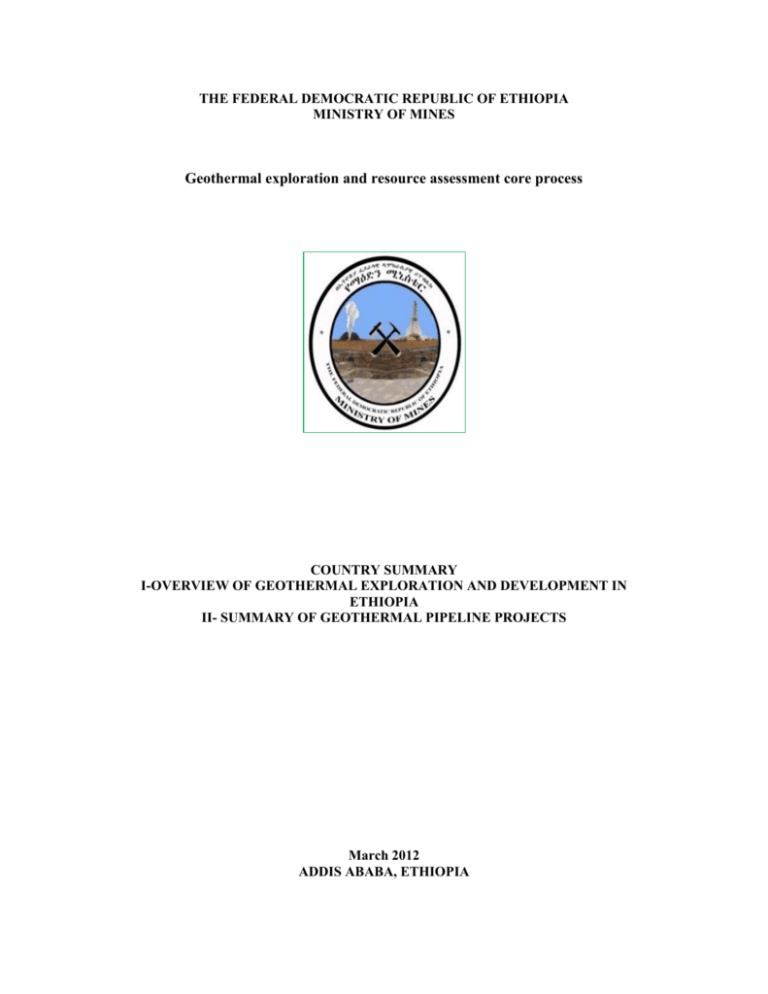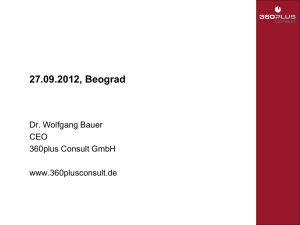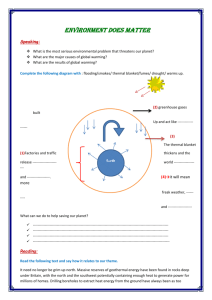The country summary geothermal exploration in Ethiopia
advertisement

THE FEDERAL DEMOCRATIC REPUBLIC OF ETHIOPIA MINISTRY OF MINES Geothermal exploration and resource assessment core process COUNTRY SUMMARY I-OVERVIEW OF GEOTHERMAL EXPLORATION AND DEVELOPMENT IN ETHIOPIA II- SUMMARY OF GEOTHERMAL PIPELINE PROJECTS March 2012 ADDIS ABABA, ETHIOPIA I. OVERVIEW OF GEOTHERMAL EXPLORATION AND DEVELOPMENT IN ETHIOPIA Ethiopia is among the few countries in Africa with a significant amount of geothermal resources. These resources are found scattered in the Main Ethiopian Rift and in the Afar Depression that covers an area of 150,000 Km2 (Figure 1). Based on the results of the investigations, Ethiopia could possibly generate more than 5000 MWe of electric power from geothermal resources alone. Ethiopia launched a long term geothermal exploration undertaking in 1969. About sixteen geothermal prospect areas are judged as having potential for electricity generation. A much larger number are capable for direct use applications (e.g. horticulture (for maximizing production in flower farming), agro-industry etc). Exploration work peaked during the early to mid-1980s when exploration drilling was carried out at the Aluto-Langano geothermal field. Eight deep exploratory wells were drilled to a maximum depth of 2.5 km and temperature up to 350° C, of which four are potentially productive. During the early 1990s, exploration drilling was also carried out at Tendaho. Three deep (about 2100m) and three shallow (about 500m) wells were drilled at the Tendaho geothermal field, and proved the existence of high temperature and pressure fluid. Other geothermal prospect areas in the Ethiopian Rift Valley are at various stages of exploration that vary from reconnaissance to detailed geoscientific studies including drilling of temperature gradient (TG) wells. A new era of resource utilization started in 1998 by installing the 7.2 MWe net capacity pilot power plant at Aluto-Langano. Initially, there was a disruption in power generation due to technical problems. These were studied and are currently being rectified. The plant is now achieving partial generation (5MWe). During the last three decades that geothermal resources exploration work was carried out in Ethiopia, a good information base and a good degree of exploration capacity, in human and infrastructure terms, have accumulated, ensuring that selected resources sites can be advanced to the resource development phase much more rapidly than before. In view of the above, the government is planning the following tasks for the coming four years: Expansion of the Aluto-Langano Geothermal Pilot Power Plant Work at Tendaho geothermal field for progressing it towards development; and Completion of the detailed exploration works at two more geothermal prospects. 1 Fig.1 Location Map of the Geothermal Prospect Areas within the Ethiopian Rift Valley. 2 Status of Geothermal Exploration and Development No. 1. Prospect Aluto-Langano Recon. Explor ation Surface Exploration Yes Yes Temperature Gradient wells Exploration Drilling Drilling Yes Estimated Potential (MWe) Developed For 30 Years Yes 30 Pilot Power Plant (5 MWe) 2. Tendaho Yes Yes Yes Yes 20 No 3. Corbetti Yes Yes Yes No Not Known No 4. Tulu Moye Yes Yes Yes No Not Known No 5. Abaya Yes Yes No No Not Known No 6. Dofan Yes Yes No No Not Known No 7. Fantale Yes Yes No No Not Known No 8. Others (Teo, Kone, Danab, Meteka, L .Abe) Yes No No No Not Known No (Dubti) II. GEOTHERMAL PIPELINE PROJECTS The following are three projects that the Ethiopian government wishes to implement. These Projects include: PROJECT 1- Tendaho Geothermal Resource Development PROJECT 2. Aluto - Langano Geothermal Pilot Power Plant Rehabilitation and Development PROJECT 3: Surface Exploration in Five Geothermal Prospects and Development of Two selected geothermal Fields PROJECT 1- TENDAHO GEOTHERMAL RESOURCE AND DEVELOPMENT The overall objective of project 1 is to increase the level of knowledge that exists for the Tendaho geothermal field to a level that would encourage a developer to assume responsibility for its development. The project is proposed to deal with progressing the geothermal resource identified by earlier exploration in Dubti area, Tendaho, to the development phase with the purpose of supplying electricity to the national grid that is planned to be extended to Semera. Detailed geoscientific studies (geology, geochemistry and geophysics) followed by the drilling of temperature gradient wells were carried out in two phases during the late 1970s to the early 1980s. Exploration drilling was carried out during 1993-95 with financial and technical assistance from the Italian government. The Geological Survey of Ethiopia carried out further drilling during 1997-98 using its own budget. Three deep (maximum 2100m) and three shallow exploratory wells (about 500m) were drilled during 1993-98 period. The three shallow exploratory wells are productive with a potential of at least 3-5MW electric power generation. Currently, well testing and reservoir engineering studies and geochemical monitoring of the shallow geothermal reservoir is in progress towards the objective of carrying out the feasibility 3 study followed by installation of small scale pilot power plant using the existing shallow productive wells. All electric power generated in the Afar region is from Diesel generators. Diesel fuel is imported, and transported from the Port of Djibouti at high cost. Therefore, the proposed geothermal resource exploration and development programme would provide power for the Dubti farm and towns of Semera, Logiya, Dubti and Det Bahri. PROJECT 2. Aluto - Langano Geothermal Pilot Power Plant Rehabilitation And Development The Aluto-Langano Geothermal field The Aluto-Langano geothermal field is located on the floor of the Ethiopian Rift Valley about 200 km south east of Addis Ababa (Figure 1). In the Aluto-Langano geothermal field, eight deep exploratory wells were drilled to a maximum depth of 2500m, between 1981 and 1985, out of which four are potentially productive. The maximum reservoir temperature encountered in the productive wells is about 350ºC. A new era of resource utilization started in 1998 by installing the 7.2 MWe net capacity pilot power plant at Aluto-Langano. Initially, there was a disruption in power generation due to technical problems. These were studied and are currently being rectified. The plant is now achieving partial generation (5MWe). The project deals with expansion of the Aluto-Langano geothermal field to full potential field, which has been estimated to be 30MWe. PROJECT 3: Surface Exploration in Five Geothermal Prospects (Corbetti, Abaya, Tulu Moye, Dofan and Fantale) and Development of Two selected Fields The project deals with investigating five resource prospects by surface exploration techniques. The selection of the five prospects was based on economic criteria and their strategic locations with respect to proximity to the existing grid and to regions of high population density. Past exploration information was the basis for selecting these prospects among several others that could be considered. Greater distance to the grid has precluded the selection of several equally attractive prospects located in the Southern, Central and Northern Afar regions. The project will be implemented into two phases: Phase 1: Surface exploration in the selected geothermal prospect areas; and Phase 2: Exploration drilling and power development at the two selected prospects. The following five selected geothermal prospect areas are presently at various stages of surface exploration. The Corbetti Geothermal Prospect area The Corbetti geothermal prospect area (Figure 1) is located about 250 km south of Addis Ababa. Eight temperature gradient wells have been drilled to depths ranging from 93-178m. A maximum temperature of 94C was recorded. The data show the probable existence of a deep reservoir with temperatures exceeding 250 C. A 132 KV power transmission line passes within 15 kms of the prospect and is the main trunk line to Southern Ethiopia, to towns along the two branch of the highway to Kenya. 4 The Abaya Geothermal Prospect area Abaya is located on the northwest shore of Lake Abaya, about 400 km south by road from Addis Ababa. Spring temperatures are as high as 96 C with a high flow rate. Integrated geoscientific studies (geology, geochemistry, and geophysics) have identified the existence of a potential geothermal reservoir with temperature in excess of 260C. The 132 KV transmission line to Arba Minch to the south parts at the Wolayta Soddo substation is located about 40 kms to the NNW of the prospect. This raises the prospect for development of the resource once it is adequately explored, including by drilling. The Tulu Moye-Gedemsa Geothermal Prospect area During 1998-2000, integrated geological, geochemical and geophysical studies including shallow temperature gradient surveys (150-200m) , confirmed the existence of geothermal reservoir with a temperature of about 200C and target areas for further deep exploration wells were delineated. This prospect area is located close to the Koka and Awash II and III hydro-electric power stations, the associated 230 and 132 KV substations and transmission lines. The Dofan Geothermal Prospect Area The presence of several hydrothermal manifestations (fumaroles and hot springs) within the graben, together with an impervious cap, needs to be regarded with high priority for further detail exploration and development. The area is located about 40 kms distance from the high voltage substation in Awash town. The Fantale Geothermal Prospect Area The Geological Survey of Ethiopia has carried out detail geological, geochemical and geophysical investigations in order to delineate and select target areas for deep exploration wells. 5





